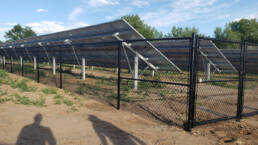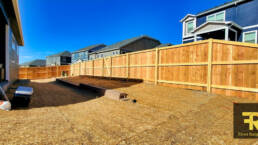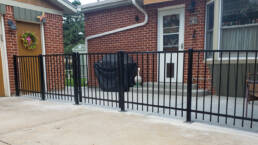Adding a fence to your home improves your home’s curb appeal, can add security and privacy, and define areas on your property. Discover the types of fences you may consider and how to decide which is right for your home.
Security Fences
Security fences create a barrier to keep people on the proper side, both inside and out. The different types of security fences offer differing amounts of security plus shave varying degrees of aesthetic appeal.
Chain-Link
Chain-link fences are the go-to option for low-end security fencing. It’s often less expensive to install than most other fencing materials, has almost no maintenance, and will effectively provide a security barrier. Many neighborhoods have restrictions on chain link fences because it’s not as attractive as other fencing materials.
Steel Security
A step up from chain link is steel fencing. They’re more expensive than chain link but still less than most other materials. They won’t offer any privacy, but they are just as effective for security.
Wrought Iron
Wrought iron is at the high end of security fences. These offer many different finial styles available to put atop the iron rods, usually running into fewer obstacles in mid- to high-end neighborhoods. They offer more sturdiness than chain link or steel security fences but continue to be wonderfully low-maintenance. They cost substantially more to install and are prone to rust in some climates.
Privacy Fences
While privacy fences may provide some amount of security, their primary purpose is to provide privacy behind the fence. The difference in types of privacy fences is mainly aesthetics and then how much privacy they offer.
Standard Wood Privacy
Most people are very familiar with the standard wood privacy fence that stands about 6 feet tall and uses 4-inch wide boards. Standard privacy fences are flat across the top, giving them a uniform look. Any wood fence needs staining and sealing, which makes them more challenging to care for than chain link, steel, or wrought iron. Because they inhibit viewing the property, some neighborhoods have rules about using privacy fences.
Ornate Wood
You can change the feel of your privacy fence by using different types of wood and changing the wood orientation. While the vertical layout is the least expensive, some fences use diagonal or horizontal board orientation. You can further improve on the aesthetics by slightly reducing the height of the fence and topping it with lattice or putting finials on top of the posts. You can also cut the wood to create a wave pattern rather than having it go straight across the top.
Vinyl Fences
You may want less maintenance than what you’ll have with a wood panel privacy fence, which is why many people choose vinyl in place of wood. However, some people think it looks cheaper than wood, though the materials usually cost more than wood.
Semi-Privacy Fences
One of the problems with privacy fences is that it cuts out everything beyond the fence. While this provides the privacy you may want, it can also make the space seem smaller or more claustrophobic feeling. The alternative is a semi-private fence, which puts a gap between the fence panels. Some designers angle the panels so that you have to look at the fence from a particular direction to see past it. You can construct semi-privacy fences from both wood and vinyl.
Other Fences
There are several other types of fences that don’t fall into either privacy or security styles. Each option has a different aesthetic style and will offer a variety of functions.
Lattice Fencing
Lattice is popular for people who prefer to incorporate plants into their fencing options. It’s often paired with vining flowers, fruit, or vegetables. Over the growing months, a properly cultivated lattice can provide as much privacy as a privacy fence, but leaves it a little more open during the non-growing months. You can find lattice made from both wood and vinyl to match your particular need and style.
Metal Panel
Metal paneling installed horizontally between brick columns provides a very modern aesthetic if that’s your primary concern. It offers an intermediate level of privacy and security as well. The cost of metal paneling is a drawback, making this style land at the higher end of fencing projects.
Classic Picket Fences
The classic white picket fence was once a staple among suburban homes. This fence construction is best used when you need to mark a boundary, but aren’t concerned about gaining privacy or security. It’s most successfully used when you’re growing plants in front of or behind the fence to give some contrast and soften the look of the fence. This is a great option for anyone looking to provide a boundary for landscaping but who wants to keep a modest budget.
Vinyl Picket
Like privacy fences, vinyl picket fences have less maintenance than their wood counterparts. If you are strongly attracted to the aesthetics of a picket fence, you’ll want to stay with the wood options. However, vinyl offers many customization options, such as solar light finials to put on atop the posts.
Choosing the Right Fence
Choosing the right fence requires a bit of legwork. Start by looking at any fencing restrictions in your HOA agreement. Next, make sure you know the property line, and the restrictions of how close to the line you can put the fence. Now it’s a matter of deciding the function you need it to perform and the budget you have. These two together will then help you narrow down the style and construction material.
Contact us to schedule a consultation with one of our fencing experts and find the perfect fence for your home.

Contact us today to discuss your fencing needs and schedule an onsite estimate.
Let us help you create a secure, beautiful, and enduring fencing solution that complements your property and exceeds your expectations. Experience the difference of our top-notch fencing services and join our list of satisfied customers.
Like this article? Spread the word!
Related Posts
January 25, 2023
Fence and Gate Repairs Save Replacement Costs
When things start going wrong with your fence and gate, your natural inclination might be to consider replacing the…
0 Comments6 Minutes
May 20, 2024
From Classic to Contemporary: Exploring Trendy Designs for Custom Residential Fences
Explore trendy residential fence designs in Denver, from classic to contemporary. Learn how Front Range Fence can…
0 Comments14 Minutes
April 23, 2024
The Ultimate Guide to Enhancing Your Home with a Beautiful Residential Fence
Discover how to enhance your Denver area home with a beautiful residential fence. Our guide covers materials, design,…
0 Comments22 Minutes




